
- Weill Cornell Medicine


Slips, Trips, and Falls: Understanding, Preventing, and Mitigating Risks
By Gian Joseph, Safety Advisor
As we enter the rainy and cold season, we face several risks , which include slips , trips, and fall s in our day-to-day activities. It is important t o be aware of hazards around us and learn how to properly identify and assess any risks with each step.
Slips, trips, and falls (STFs) are common accidents that can lead to severe injuries. These incidents occur in various settings, from homes and workplaces to public spaces , and i t is essential to understand the causes, consequences, and , most importantly, strategies for prevention and mitigation.
1. Understanding the Dynamics of STFs. STFs are caused by the following .
Insu fficient friction between the shoe and the walking surface. Common causes include wet or greasy floors, spills, and loose debris (Slip and Fall Accidents, 2021).
When a person's foot collides with an object or an uneven surface, it caus es them to lose balance. Typical trip hazards include cluttered walkways, electrical cords, uneven flooring, and damaged or upturned mats (Slip and Fall Accidents, 2021).
2. The Impact of STFs
Slips, trips, and falls have far-reaching effects, affecting individuals and society . Personal i njuries range from minor cuts , bruises, sprains , and abrasions to fractures, dislocations, and head injuries (National Safety Council, 2021). The medical expenses associated with treating STF-related injuries can be substantial , including hospital stays, surgeries, rehabilitation, and ongoing care (National Safety Council, 2021). STFs can result in missed workdays and reduced productivity for both individuals and employers. Workers' compensation claims and absenteeism contribute to economic costs (National Safety Council, 2021). Lastly, t he physical and psychological consequences of STFs can limit mobility, independence, and overall quality of life, especially among older adults ( Sahyoun et al., 2020).
3. Prevention and Mitigation Strategies
Preventing and mitigating STFs involves a combination of awareness, environmental modifications, and education . H ere are some ways you can take precaution s against STFs in your daily activities;
Clear Pathways: Maintain clear, unobstructed walkways by removing clutter and tripping hazards such as cords, toys, and loose rugs (Occupational Safety and Health Administration [OSHA], 2002).
Adequate Lighting: Ensure proper lighting in all areas, both indoors and outdoors, to improve visibility and reduce the risk of tripping over obstacles (OSHA, 2002).
Slip-Resistant Flooring: Install slip-resistant flooring materials, especially in areas prone to moisture, like bathrooms and kitchens (OSHA, 2002).
Footwear: Encourage the use of proper footwear with good traction, especially in environments where slip hazards are prevalent ( Sahyoun et al., 2020).
Handrails and Guardrails: Install and maintain handrails and guardrails on stairs, ramps, and elevated platforms to provide support and prevent falls (OSHA, 2002).
Warning Signs: Use signage to alert individuals to potential hazards, such as wet floors or uneven surfaces (OSHA, 2002).
Education and Training: Promote awareness and provide training to individuals on recognizing and avoiding STF hazards (National Institute for Occupational Safety and Health [NIOSH], 2015).
Workplace Safety: Employers should implement safety protocols and conduct risk assessments in the workplace, addressing potential STF risks (NIOSH, 2015).
Regular Maintenance: Routinely inspect and maintain buildings, walkways, and outdoor areas to identify and address potential hazards promptly (NIOSH, 2015).
4. A Holistic Approach to STF Prevention
Preventing and mitigating STFs require a collaborative approach involving individuals, organizations, and communities:
Individuals : Exercise caution when walking, especially in unfamiliar or potentially hazardous environments. Wear appropriate footwear and take your time, especially in wet or slippery conditions ( Sahyoun et al., 2020).
Employers: Create a safe work environment by identifying and mitigating STF risks. Provide training to employees on safety protocols and the proper use of equipment (OSHA, 2002).
Property Owners and Managers: Ensure properties are well-maintained and free from hazards. Regularly inspect and address issues promptly (NIOSH, 2015).
Government and Local Authorities: Enforce building codes and regulations that promote safety, especially in public spaces and commercial buildings (OSHA, 2002).
Conclusion
Slips, trips, and falls are preventable accidents that carry substantial personal, economic, and societal costs. By comprehending the causes, consequences, and prevention strategies, we can significantly reduce the incidence of STFs and mitigate their impact. Whether at home, at work, or in public spaces, prioritizing safety and fostering awareness about STFs is crucial for the well-being of individuals and communities. Let us strive collectively to create environments where everyone can move safely and confidently, free from the fear of falling.
References:
National Institute for Occupational Safety and Health (NIOSH). (2015). Preventing Slips, Trips, and Falls in Wholesale and Retail Trade Establishments. https://www.cdc.gov/niosh/docs/2015-100/pdfs/2015-100.pdf
National Safety Council. (2021). Injury Facts. https://injuryfacts.nsc.org/work/overview/work-safety-introduction/work-...
Occupational Safety and Health Administration (OSHA). (2002). OSHA Publication 3151-12R. Preventing Slips, Trips, and Falls in Wholesale and Retail Trade Establishments. https://www.osha.gov/Publications/osha3151.pdf
Sahyoun , N. R., Pratt, L. A., & Lentzner , H. (2020). The Changing Profile of Nursing Home Residents: 1985-1997. Journal of Aging and Health, 12(3), 336-363.
Slip and Fall Accidents. (2021). InjuryClaimCoach.com. https://www.injuryclaimcoach.com/slip-and-fall-accidents.html
Please note that the sources cited are accurate as of the time of writing this article. For the most current information, consult authoritative sources and local health authorities.
Go to the staff directory for individual contacts within EHS. You may also use the Weill Cornell Medicine online directory to search for faculty and staff.
Create an EHS Incident
Weill Cornell Medicine Environmental Health and Safety 402 East 67th Street Room LA-0020 New York, NY 10065 Phone: (646) 962-7233 Fax: (646) 962-0288
- ASSP Community
- Member Benefits
- Member Types and Qualifications
- Employer Justification
- ASSP Fellows
- Past Recipients
- Region SPY Past Recipients
- Practice Specialty/CIG SPY Past Recipients
- Chapter SPY Past Recipients
- Chapter SPY Recipients Archive
- Council Safety Professional of the Year Award
- Committees and Committee Members
- Committee Leadership Roles
- Leadership Connection
- Online ASSP Community
- Local Chapters
- Environmental
- Fire Protection
- Global Operations
- Industrial Hygiene
- Manufacturing
- Public Sector
- Risk Management
- Training and Communications
- Transportation
- Member Mentoring
- Membership Directory
- Get Involved
- Board of Directors Elections
- Council Vice President Elections
- Regional Elections
- Practice Specialty Elections
- Common Interest Group Elections
- Nominations
- Past ASSP Election Results
- Election Resource
- Member-Get-A-Member
- Community Leader Resources
- My Learning
- Education Catalog
- Online Learning
- Math Review
- Safety Management
- Leadership in Safety Management
- Occupational Health and Safety Management System
- Safety 2025: Call for Presenters
- Leadership Conference
- SafetyFOCUS
- Global Education
- Train Your Safety Team
- ASSP-Owned Course Proposal
- New ASSP Course Proposal
- Instructors
- Buy Standards
- Standards Development
- Active Shooter Technical Report
- Confined Spaces (Z117.1)
- Construction and Demolition Operations (A10)
- Fall Protection and Fall Restraint (Z359)
- Fleet/Motor Vehicles (Z15)
- Hydrogen Sulfide Training (Z390.1)
- Lockout, Tagout and Alternative Methods (Z244.1)
- Machine Guarding (B11)
- OSH Management (Z10)
- OSH Management (ANSI/ASSP/ISO 45001)
- OSH Training (Z490)
- PPE for Women (Z590.6)
- Prevention Through Design (Z590.3)
- Risk Management (ISO 31000)
- Safety and Health Metrics (Z16.1)
- Temporary Workers (Z590.9)
- Walking/Working Surfaces (A1264)
- Work/Aerial Work Platforms (A92)
- Certification and Accreditation
- Call for Submissions
- Book Proposals
- Share Your Story
- Online Bookstore
- Professional Safety
- Journal of Safety, Health and Environmental Research Archive
- Salary Survey
- Alliances and Affiliations
- ASSP Safety Curriculum Guidelines
- Government Affairs News
- Safe + Sound Week
- Position Statements
- Risk Assessment Committee
- ROI of Safety
- Roles and Responsibilities of the Safety Professional
- Safety Research Agenda
- President's Message
- For the Media
- Fall Protection
- Construction Safety Management Systems | ASSP
- The Case for Safety Podcast
- Career Center
- What Can You Expect From OSHA in the New Administration
- Business Skills and Leadership Webinars
- Become a Safety Professional
- By The Way, This Is Not The Way
- Apply for a Professional Education Grant
- Assessing Readiness for Total Worker Health
- Making the Business Case for Total Worker Health
- Risk Assessment and Management
- Free Training Funded by OSHA Susan Harwood Grant
- Free Field Inspection Management Software
- Apply to Join
- Membership Benefits and Qualifications
- Student News and Events
- Student Sections
- Scholarships
- Accredited Academic Programs
- Student Membership Drive
- Board of Directors
- ASSP Fact Sheet
- Past Society General Chairs and Presidents
- Code of Professional Conduct
- Society Bylaws
- Society Operating Guidelines
- Governance Proposal Background
- Strategic Plan
- Advertising and Sponsorship
- Corporate Alliance
- Current Sponsors
- Jobs at ASSP
- Staff Directory
- Diversity, Equity and Inclusion
- The ASSP Advisory Group
- Tackling Today's Safety Challenges
News and Articles
Safety news you need: preventing slips, trips and falls.
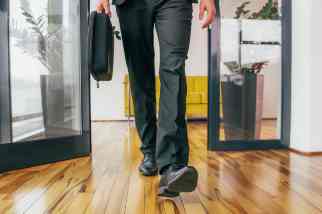
- Slips, trips and falls can occur for a variety of reasons. Learn some common causes of these types of incidents and how you can help workers avoid them. Read more
- To prevent slips, trips and falls, you first have to identify the hazards in your work environment that can cause them. Follow these steps to conduct a comprehensive risk assessment of your facility to help keep your workers safe. Learn more
- Once you’ve identified your hazards, you can then institute policies and procedures to help prevent them. Following these best practices can help you create work environments free of the factors that can cause slips, trips and falls. Read more
- Along with physical hazards, human factors can play a role in experiencing a slip, trip or fall. Use this tool to gain an understanding of how a worker’s mindset can contribute to these incidents and how you can educate them on prevention. Learn more
On Demand: Prevent Slips, Trips and Falls With ANSI/ASSP A1264 Walking/Working Surface Standards Managed Fall Protection Course ANSI/ASSP Z359.1-2020 The Fall Protection Code ANSI/ASSP A1264.2-2012 Standard for the Provision of Slip Resistance on Walking/Working Surfaces
Thank you for the comment! Your comment must be approved first
You've already submitted a review for this item
Thank you! Your review has been submitted successfully
Login to be able to comment
Are You Passionate About Safety?
Volunteer with ASSP today.
Jumpstart Your Learning
Access our latest free webinars, articles and more.
Advance Your Career
Earning an ASSP certificate can enhance your career.
Get Insight & Analysis
Learn about the latest trends in safety management, government affairs and more.
Connect With ASSP


Reducing slips, trips and falls
Hazard awareness and prevention strategies needed.

Fall hazards remain a common problem across multiple industries and workplaces. In 2019, worker deaths stemming from slips, trips and falls climbed 11.3% from the previous year, according to Bureau of Labor Statistics data. Meanwhile, OSHA’s standard on fall protection – general requirements (1926.501) has topped the agency’s Top 10 list of most frequently cited standards for 11 consecutive fiscal years.
Other standards related to inherent fall risks and that routinely populate the list include those regarding ladders (1926.1053), scaffolding (1926.451) and fall protection – training requirements (1926.503).
“Most workers have some safety knowledge, but how do we get people to consistently apply the safety practices that they know?” asked Bradley Evanoff, occupational health physician and professor of occupational and environmental medicine at Washington University in St. Louis. “How can an employer create a work culture where all employees take an active role in making the workplace safer and feel like they can speak up if they see a problem?”
Factors may overlap
During a December 2019 National Safety Council webinar on strategies for preventing slips, trips and falls, Amber Joseph, technical consultant at Liberty Mutual Insurance, identified several contributing factors. Among them:
- Walking surfaces
- People and activity
- Contaminants
“A lot of times, you’ll have overlap within these, so it may be a walking surface and a footwear discussion depending on the type of contaminant that you have in place,” Joseph said. “But really, it’s looking at this as a whole, and looking at it as, ‘All right, I need to address these areas as I move forward.’”
On the surface
Under OSHA’s standard on walking-working surfaces for general industry (1910.22), employers must ensure “all places of employment, passageways, storerooms, service rooms and walking-working surfaces are kept in a clean, orderly and sanitary condition.”
Walking-working surfaces also must be maintained free of hazards such as sharp or protruding objects, loose boards, corrosion, leaks, spills, snow, and ice. Additionally, hazardous conditions on surfaces must be “corrected or repaired before an employee uses the walking-working surface again.”
The standard adds that “if the correction or repair cannot be made immediately, the hazard must be guarded to prevent employees from using the walking-working surface until the hazard is corrected or repaired.”
NIOSH suggests that employers select flooring material based on the work that will be performed in the area. The agency also notes the importance of the factor of coefficient of friction – a measurement for the propensity to slip on a given walkway surface. The agency states that flooring with “a higher static coefficient of friction is safer” and recommends flooring with a CoF of 0.5 or greater for high-risk areas.
In November, the University of Pittsburgh announced that two researchers from its Swanson School of Engineering intend to use a NIOSH grant to develop a new model of flooring friction performance with the aim to prevent falls on the job. Citing data from Liberty Mutual, a Pitt press release notes that workplace slips and falls carry an annual expense of $10 billion in workers’ compensation claims.
Continued on page 2
Post a comment to this article
Safety+Health welcomes comments that promote respectful dialogue. Please stay on topic. Comments that contain personal attacks, profanity or abusive language – or those aggressively promoting products or services – will be removed. We reserve the right to determine which comments violate our comment policy. (Anonymous comments are welcome; merely skip the “name” field in the comment box. An email address is required but will not be included with your comment.)
Report Abusive Comment
SafeStart solves your biggest challenges - from slips, trips and falls to serious injuries and fatalities - by addressing the human factors common to all of them.
Capabilities.
Discover human factors management solutions that effectively address human error, conquer common injury challenges and improve safety engagement.
- Rate Your State
Organization
- Safety Assessment & Diagnostics
- Human Factors Review
Our safety resources give you the knowledge and stories you need to manage human factors—and won’t find anywhere else.
Safety Resources
Customer success.
- Case Studies
- Client Presentations
- Video Testimonials
Let us show you how to connect the dots between human error reduction and fewer incidents, better engagement and stronger support for safety.
Workshops & Events
- Event Calendar & Map
Please select your region
Por favor elige tu región Veuillez choisir votre région Per favore scegli la tua regione Por favor escolha a sua região Bitte wählen Sie Ihre Region aus
USA & Canada
- USA & Canada (English)
- Canada (Français)
Latin America
- America latina (Español)
- Brasil (Português)
- International (English)
- France (Français)
- Deutschland (Deutsch)
- Italia (Italiano)
- España (Español)
- UK (English)
- Asia (English)
Slips Trips and Falls
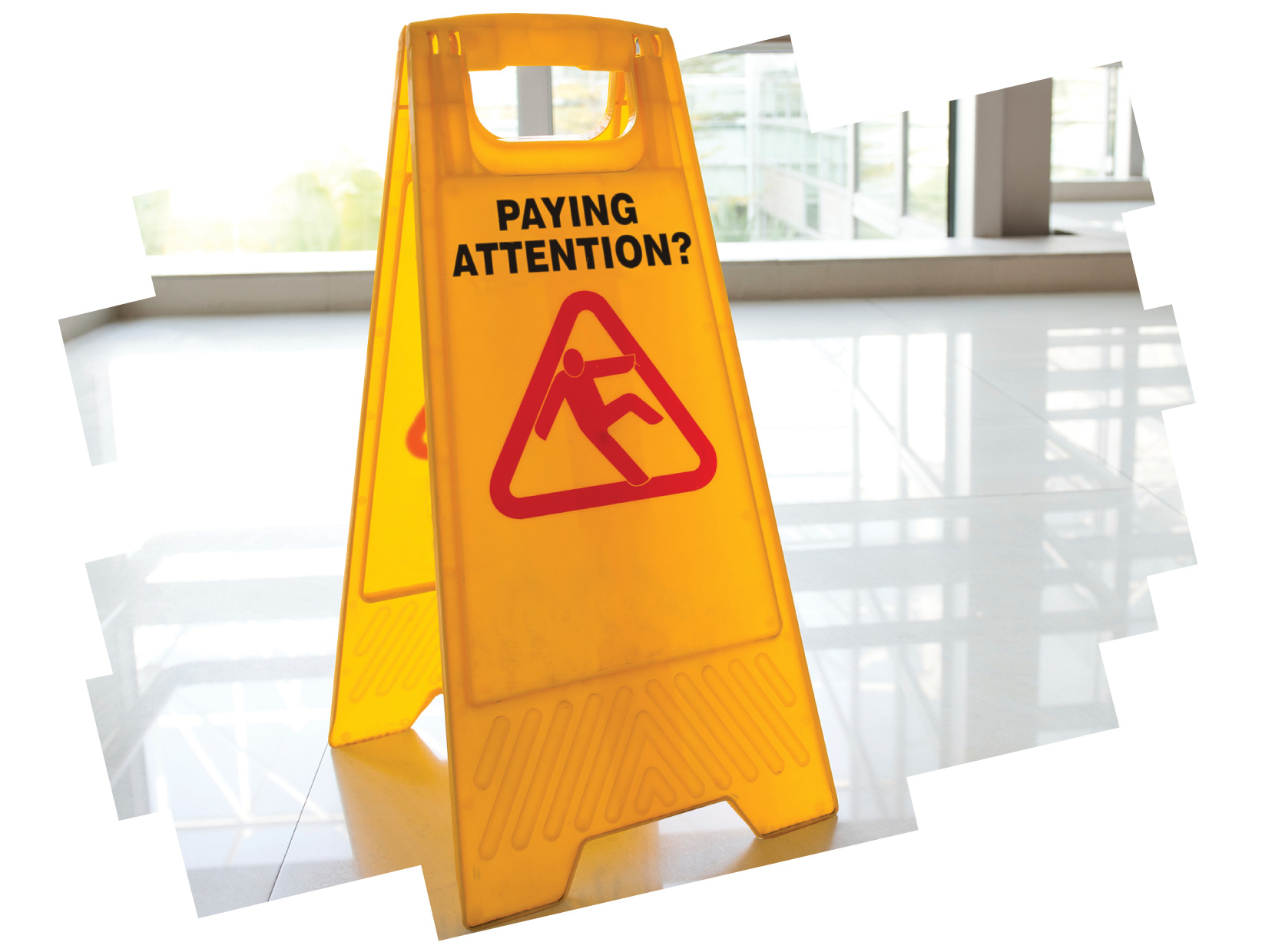
Free webinar
Slips, Trips and Falls
Slips, Trips and Falls: Balancing Human and Physical Causes
Many companies have taken steps to tackle the major physical causes of slips, trips and falls in the workplace, but human factors persist as the biggest cause of these incidents and often remain unaddressed.
Solving Slips, Trips and Falls Once and For All
This guide outlines what you can do to reduce slip, trip and fall injuries by addressing both physical causes and human factors.
Human Factors in Slips, Trips and Falls
Incorporate these slides into your existing slip, trip and fall training.
The 12 Toolbox Talks of Holiday Safety
November 23, 2022
The holidays are a busy time for everyone. There’s something to be said about the right decorations to set the tone for the season. But unfortunately for some, the holidays are also a time when injuries and fatalities increase—and it could be because people are so focused on the season that they fail to see…
Use SafeStart Teachings for a Safe Halloween
October 25, 2022
At Halloween, children can have a hard time staying focused on anything but racing to the next house for candy. This year, why not try a little SafeStart talk to get them thinking about safety? A quick reminder of these common Halloween human factors and other safety tips can help keep them safe as they…
A New Take on Slips, Trips and Falls
January 21, 2021
Regardless of profession or industry, slips, trips and falls are a problem that everyone is familiar with. The reason we are all well versed on the outcome of slips, trips and falls is that they’re a persistent problem among most companies. But sometimes slips, trips and falls aren’t taken as seriously as they should be.…
4 Winter and Holiday Safety Toolbox Talk Topics for December
November 24, 2020
The month of December brings a lot of things, most notably the holidays—there’s Christmas, Hanukkah, New Year’s Eve and a number of parties to mark the occasions. But December also brings a long list of recurring incidents and injuries year after year. The good news is you can protect your workers by delivering some well-prepared…
4 Unspoken Hazards of Waste Collection
July 2, 2019
Every day, waste collectors face a number of hazards that range from vermin to chemical poisoning. In fact, refuse and recyclable materials collection is one of the most dangerous jobs in the U.S. and most employees in this industry are likely to get injured at some point in their working lives. One of the most…
4 Common Safety Issues in the Aviation Industry
December 18, 2018
Among the many workplace hazards that affect aviation workers, falls and back injuries are the most common. The industry shares a lot of similarities with other sectors where people frequently trip and fall or hurt their backs despite engineering precautions and training on correct lifting techniques. When rushing or complacent, people are likely to ignore…
Solved: The Most Effective Way to Overcome Slips, Trips and Falls
August 30, 2018
Despite various engineering solutions used by safety managers, the number of slips, trips and falls incidents in the workplace refuses to go down. In fact, the issue remains one of the top problems for safety professionals. This subject was addressed by Ray Prest in the Winter/Spring 2018 issue of the Safety Decisions Magazine. In his…
How to Finally Get Traction on Slips and Falls in Oil and Gas
June 21, 2018
Work conditions in the oil and gas industry are often hazardous and every year many workers are hurt or killed while performing their job. And although there are numerous dangers facing oil and gas workers on a daily basis—from chemical exposure to explosions and fires—a significant number of injuries and deaths is caused by slips,…
How to Prevent Top 5 Construction Risks
April 17, 2018
Construction site safety is a concern for all those who supervise and manage the projects. Thousands of workers are injured or killed on job-sites each year, and many of those incidents are entirely avoidable. Understandably, supervisors and managers are required to maintain a safe and healthy workplace. Managing construction safety risks requires recognizing the most…
Here’s Why Safety Pros Don’t Stop More Slips, Trips and Falls from Happening at Work
January 12, 2017
Slips, trips and falls are a major safety concern in almost every industry. Based on data gathered by the National Safety Council: Falls are the third-most common cause of off-the-job deaths among workers. Slips, trips and falls account for 26% of all injury-related visits to the emergency department for people ages 25 and up. In…

3 Big Causes of Slips, Trips and Falls
May 16, 2016
This is an excerpt from our free guide on preventing slips, trips and falls. A 2014 survey of 1,294 safety professionals revealed the most frequent factors in slip, trip and fall incidents at their workplaces—and a whopping 95% of respondents cited one of three causes. The main characteristic the three biggest causes have in common…
Why You’re Still Struggling with Slip, Trip and Fall Incidents
August 31, 2015
Slips, trips and falls are a common problem in the workplace. In fact, they’re the second-leading cause of workplace injury according to the NSC Injury Facts – and they have been for quite a while. Even though most safety programs outline clear measures to prevent these types of incidents, workers still end up getting injured…
Slips, Trips and Falling into the Deep End
June 29, 2015
School’s out for summer… and that means many of us will be spending more time supervising kids while they swim. What’s more exciting than getting into the pool? Most kids, against their parent’s continual warnings, love running into and around the pool and never think about the associated risk. Decks become very slippery from the…
Free Webinar on Slips, Trips and Falls
June 22, 2015
It’s a constant balancing act to deal with slips, trips and falls in the workplace. You need to stay on top of compliance measures like housekeeping and maintenance. But the biggest cause of slips, trips and falls is worker distraction—and that requires an entirely different set of solutions. There is an exciting free webinar on how…
The Surprising Cause of Most Slips, Trips and Falls
May 5, 2015
Slips, trips and falls are a major challenge for safety professionals. Not only are they responsible for 25% of all occupational injuries that require time off work, but they’re also notoriously difficult to solve. So how do you reduce the number of slips, trips and falls in the workplace? To answer that question, you need…
Free Guide to Solving Slips, Trips and Falls
February 25, 2015
Slips, trips and falls are a problem in workplaces in almost every industry. A recent survey of safety professionals revealed the biggest three causes of slips trips and falls—and the results should make safety folks sit up and take notice. It turns out that the majority of slips, trips and falls involve human factors. Whether…
Infographic on Slips, Trips and Falls
February 10, 2015
A new report from BLR Safety Daily Advisor shows how safety professionals view the problem of slips, trips and falls in the workplace. The report was produced after surveying over 1,200 safety professionals about the impact of slips, trips and falls on their workforce and which solutions they’ve implemented to deal with the issue. The…
- Report a Claim
- Quick Resources

Slips Trips and Falls
Slips, Trips, and Falls
By Kevin Bartsch, Assistant Director Workers Compensation Pool Operations
Even though winter was a bit delayed in its arrival this year, recent storms have now provided us with snowfall over nearly all of the state. So, it is a good time to once again discuss the important topic of preventing Slips, Trips, and Falls in the workplace. We can avoid many of these injuries – along with most of the financial costs and the related toll on morale, productivity, and human resources – if we take the necessary measures to identify and reduce the causes of these all-too-common accidents.
Now that winter storms have hit and more are will no doubt soon be coming, we need to be thinking about how to safely deal with snow. For starters, when it is snowy, select appropriate footwear to ensure good traction. Using Ice Trackers or Yak Trak-type devices on ice is a good choice. Also, keeping a small bottle of sand in your car to use as a self-sander can help when you encounter that unexpected ice patch. Also, to avoid a possible slip when exiting or entering your vehicle, place a hand on the door, a hand on the steering wheel, and your feet on the ground – this three-point contact method can make a world of difference in these situations. Also, keep in mind that slips do not happen exclusively due to snow and ice conditions at our school facilities; so, be watchful for wet floors or any kind of slippery clutter, such as loose papers. A water spill or debris on floors resulting from poor housekeeping can often increase the potential for a slip event. Finally, make sure the appropriate staff are made aware so as to ensure the situation is addressed as soon as possible.
Trips are another claim area we can work together with our colleagues to address by being vigilant, by partnering with maintenance and other staff to maintain clear pathways, and by ensuring that housekeeping mitigates the risks their routine work can create. When items such as backpacks, chairs, garbage cans, and boxes are left in the wrong places – and especially when they are left in the line of busy walkways – the chances for a tripping event increase significantly. Similarly, if there are extension cords in use, they, too, can cause problems. It’s best to ensure that the cords are appropriately covered with tape or a mat and that other work-related implements are attended to with an eye for injury-prevention. Finally, encourage your staff to focus , literally and figuratively, on safety when moving about the building, especially when they are carrying heavy items or multiply items, as distracted colleagues are often the victims of tripping events.
Unfortunately, most of us do not have gymnast-like abilities and are thus woefully unable to “stick the landing” when falling from the forbidden top rung of a ladder or tumbling from atop an unsteady chair stacked unwisely on a table or another chair – and of course, the best we should hope for when we tempt fate in these ways is a 1-point deduction by terrified onlookers; the worst, and unfortunately more likely, outcome is a painful break and an exceptionally expensive claim. In brief, falls are all-too-common and typically avoidable sources of injury, and they are often surprisingly serious because they involve heights and awkward landings. So, to decrease the likelihood that any of your employees experience a long stay in a hospital bed eating bland food and watching bad TV, make sure they know how to use ladders and step stools safely when reaching things above head height. Further, insist that they NEVER, and I really mean NEVER , step on a wheeled chair to get to an item they need to reach. The little bit of extra time and due diligence it takes to get the appropriate stool or ladder will be invaluable, and certainly preferable to time spent in a hospital. And if a lift of any sort is needed to be used to reach items involved in maintenance work, ALWAYS ensure the only staff using the device have been properly trained on its use and safety features. Please NEVER allow students, or anyone not properly trained, to use man-lifts, ladders, or scaffolds. Finally, do all that you can to ensure everyone reads the manufacturer’s directions and follows the safety guidelines.
Finally, if you see something, say something. We all need a reminder now and again if we’ve forgotten safe practices or might be tempted to take a quick shortcut. So, if you witness a co-worker engaging in unsafe actions such as those noted above, offer to help them perform the action safely or to get the appropriate equipment.
Now that winter is here to stay, please be mindful, aware, and watchful when it comes to helping to Prevent Slips, Trips, and Falls in your facilities.
Be Safe! Return to newsletter
Community Tags
- +1 (800) 826-0777
- VIRTUAL TOUR
- Mass Notification
- Threat Intelligence
- Employee Safety Monitoring
- Travel Risk Management
- Emergency Preparedness
- Remote Workforce
- Location and Asset Protection
- Critical Communication
- Business Continuity
- Why AlertMedia
- Who We Serve
- Customer Spotlights
- Resource Library
- Downloads & Guides
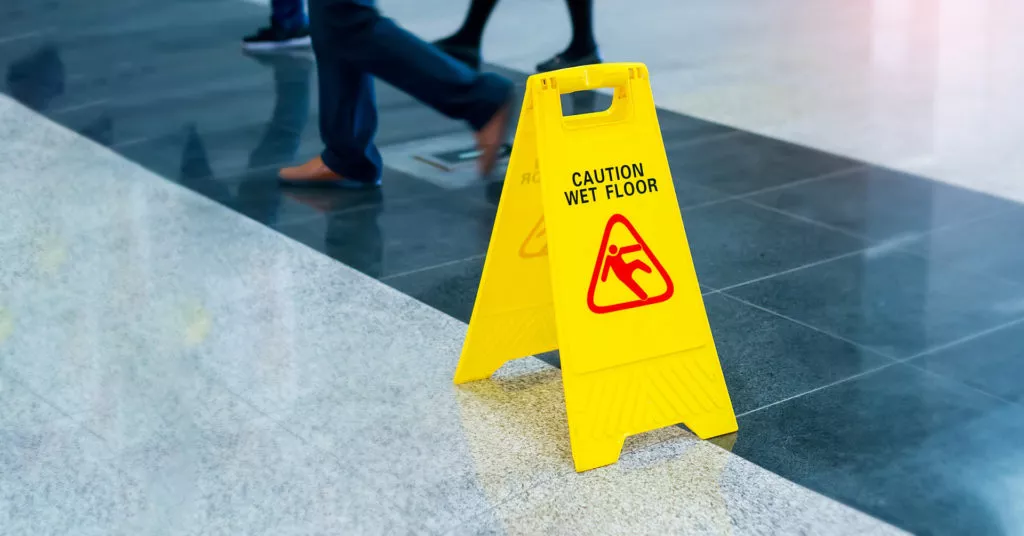
Prevent Workplace Slips, Trips, and Falls—8 Safety Tips
Mopping up a spill or double-checking a guardrail might seem like simple common sense, but slips, trips, and falls are the second most common cause of death at work. These are life-saving procedures. Keep reading for practical tips to prevent workplace accidents.
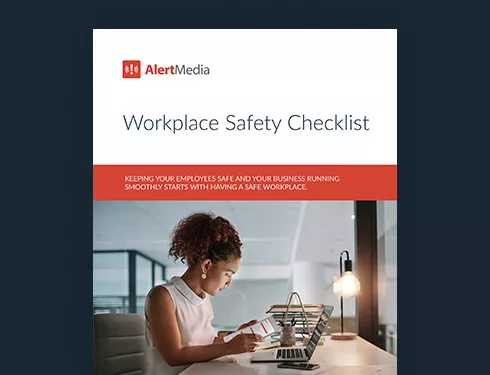
- Slip, Trip, and Fall Hazards Listed
- Clarifying OSHA Standards
- Prevent Workplace Slips, Trips, and Falls
These are familiar scenarios at home: slipping on a wet floor in the kitchen and tripping over a toy left out by the kids. While annoying, these accidents are typically minor hazards in the home. You might stub your toe, but rarely are there severe consequences.
In the workplace, it’s a different and far more serious story. Slips, trips, and falls account for over 200,000 workplace injuries per year. In 2020, nearly one in five accidents leading to missed work was due to a slip, trip, or fall. They’re also the second-leading cause of workplace fatalities.
As a safety leader, you’re responsible for your company’s duty of care and for providing a safe workplace . This blog post will examine common hazards leading to slips, trips, and falls and the steps you can take to minimize injury risks for your team.
Download Our Workplace Safety Checklist
What are slip, trip, and fall hazards in the workplace.
Accidents involving slips, trips, and falls are often grouped together. While they’re similar, it’s important to understand the distinction since they each have different causes and consequences.
Slips occur when someone’s footwear loses traction with the surface they’re on, causing a loss of balance. Under some circumstances, slipping can lead to a fall.
Trips happen when someone hits their foot or lower leg on an object. As their upper body continues moving forward while their lower body remains stationary, the person may lose their balance in the process.
Falls often result from slips or trips, but they can also happen on their own. For example, a worker on a ladder or scaffolding can lose their balance and fall without slipping or tripping. Falls are also possible on flat surfaces and can still cause serious injuries.
Once you understand the hazards that lead to each type of accident, you can identify and mitigate risks in your workplace. Here are some of the most common causes of slips, trips, and falls in the workplace:
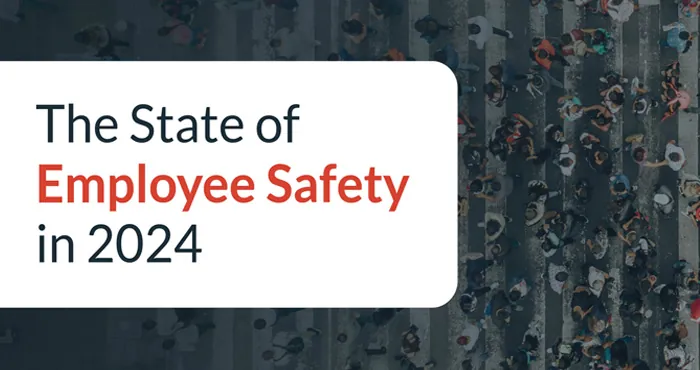
Slip Hazards
- Spills of wet or dry substances
- The cleaning process during spill removal
- Employees rushing or not paying attention to workplace conditions, especially while carrying objects
- Slippery floor surfaces such as marble or laminate
- Wet surfaces
- Poor lighting that obscures hazards
- Inappropriate footwear for the environment
- Transitioning between different types of surfaces
Trip Hazards
- Objects or obstructions in walkways
- Uneven surfaces on flooring or concrete
- Cables, cords, and hoses that aren’t properly secured or organized
- Unmarked steps or ramps
- Irregular stairs or stairs without railings
- Carpet, rugs, or mats with wrinkles or lifted edges
Fall Hazards
- Improperly used or poorly maintained ladders
- Elevated surfaces without guardrails
- Floor and wall openings
- Working in elevated environments without a safety harness
- Ill-fitting or improperly used PPE, such as helmets and safety lines
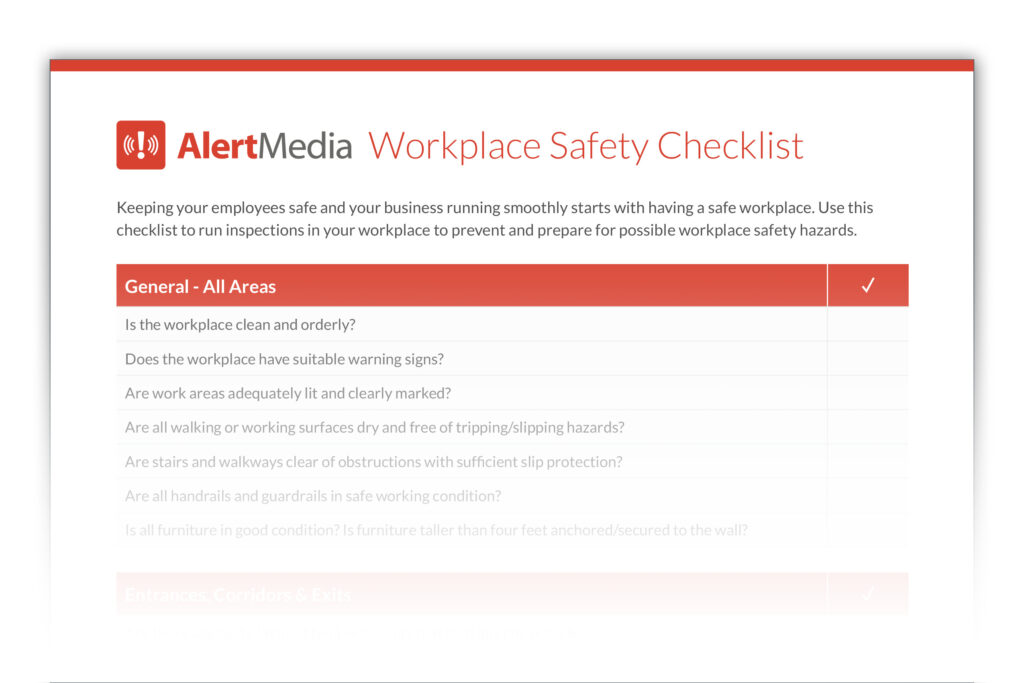
Preview the Workplace Safety Checklist
Are There OSHA Standards Related to Slips, Trips, and Falls?
Despite how common these injuries are, there is no specific OSHA standard on slips, trips, and falls. However, several OSHA rules indirectly address the same hazards.
The most important regulation to be aware of is 29 CFR 1910 Subpart D, which covers walking and working surfaces. OSHA updated the standard in 2017, introducing many upgrades to fall protection system requirements, improved employer-provided inspection guidelines, and a greater emphasis on safety training for employees.
For the construction industry, 29 CFR 1916 contains numerous fall-related regulations. Subpart M specifically addresses fall prevention, but other sections, such as Subpart L (scaffolds) and Subpart E (personal protective and lifesaving equipment), are also relevant. OSHA used 29 CFR 1916 as guidance when revising 29 CFR 1910, so the two guidelines now reflect many of the same OSHA violations .
As with any other workplace hazard or accident, OSHA recordkeeping requirements still apply in the event of a slip, trip, or fall incident. Internally, the reporting process is also an opportunity to review the details of the incident and determine how you can update your workplace safety policy to prevent similar accidents in the future.
How to Prevent Slips, Trips, and Falls in the Workplace
Many hazards that cause slips, trips, and falls are inevitable. However, injuries and accidents are not. To prevent slips, trips, and falls, train your employees to follow a three-step process:
- Recognize the hazard: Identify conditions that could lead to a slip, trip, or fall.
- Evaluate the hazard: Examine the situation and determine what level of risk it presents and who it affects.
- Control the hazard: Avoid the risk by removing the hazard (such as mopping up a spill) or implementing safety equipment and procedures (such as installing handrails on an elevated platform).
Here are eight workplace safety tips to prevent falls, trips, and slips.
1. Teach situational awareness
Since many causes of slips, trips, and falls are foreseeable, situational awareness in the workplace is one of the best preventative measures. Encourage your employees to pay attention to their surroundings and the risks they present:
- Look at walking surfaces for spills, obstacles, or other potential hazards
- Watch for signage that warns of increased hazards
- Be aware of conditions such as weather or time of day that might increase the risk of an accident
- Take shorter and more cautious steps on slippery surfaces
2. Encourage proper footwear
Like any other form of PPE, proper footwear can significantly reduce the risk of accidents. Research has found that slip-resistant shoes can reduce injury claims by 67% in environments with slippery work surfaces.
Employees should regularly inspect their shoes and make sure the soles aren’t worn out, as the lack of tread increases the danger of slipping. Additionally, anyone who works in conditions exposed to winter weather hazards should wear insulated boots. Cold temperatures can decrease muscle function, increasing the risk of slipping, tripping, or falling.
3. Utilize signage
Signage is an effective warning system for many workplace risks, but it can be especially effective in preventing slips, trips, and falls. There are two types of signs you can use to increase occupational safety:
- Temporary: Use warning signs while addressing a new hazard, such as cleaning up a spill, repairing a handrail, or replacing a ripped carpet. While temporary signage can help prevent injuries, you still need to address the actual hazard as quickly as possible.
- Permanent: For unavoidable hazards, such as slippery surfaces, a permanent sign can help warn employees to be careful. Use these sparingly, though, as it’s easy for people to ignore signs they see every day.
4. Keep floors clear and clean
Good housekeeping can help prevent most slips, trips, and falls. The details of keeping walking areas clean will vary widely by work environment, but there are a few common themes to encourage workplace safety:
- Report spills immediately, and warn nearby employees until someone can clean the contaminated surface
- Keep walkways clear of obstacles, loose objects, and anything that someone could trip over
- Place mats at entrances and exits so people can dry their shoes and avoid tracking water or other substances around the workplace
- Install handrails on stairways and elevated walkways
5. Apply non-slip mats and coatings
In some situations, keeping floors from becoming slippery is nearly impossible. Whether it’s liquid splashing or steam condensing, you must focus on mitigating the risk rather than avoiding it altogether.
For smaller or less demanding settings, non-slip mats can help employees maintain traction while walking around. In other cases, treating the floor with a permanent coating can help reduce slipping risks, even in the constant presence of liquids.
Who is at risk for slips, trips, and falls?
While all industries have some level of risk for a slip, trip, or fall, there are some industries where the risk is much higher, and the potential result could be much more dangerous. Here are some of the highest-risk industries:
- Construction
- Manufacturing
- Transportation/shipping/logistics
- Outdoor maintenance/groundskeeping
- Foodservice/hospitality
6. Ensure proper lighting
To identify slip, trip, and fall hazards, your employees need to be able to see their surroundings. Make sure that all of your work areas have proper lighting, especially in areas that are more prone to unsafe conditions.
While this can be a challenge in outdoor work environments, especially at night, it’s even more critical in those situations. Environmental conditions can lead to increased risks, and employees need to be able to see and avoid them. Adequate lighting should also extend to parking lots and walking areas around your facilities.
7. Develop safety programs
Your company’s safety plans and programs should include specific guidelines for preventing slips, trips, and falls. There are a few key topics to consider when developing these policies:
- The types of surfaces employees work and walk on and whether they present extra risks
- Seasonal or regional conditions that could heighten hazards, such as winter weather threats
- Specific OSHA regulations that apply to your workplace
- Potentially hazardous equipment training such as ladder safety
- Regular inspection plans to ensure your team is maintaining a safe work environment
- Policies to report hazards using your company’s two-way communication platform
- First aid training , so employees are prepared to respond safely should injuries occur
8. Provide Slips, Trips, and Falls Training
Lastly, training your employees to avoid slips, trips, and falls will help keep them safe. Provide specific guidance on the environments they’ll work in and the hazards they’ll face. For example, a slips, trips, and falls safety talk for food service workers should focus on wet floors and walking safely in crowded, fast-paced environments. Conversely, office workers could use extra reminders to watch for stray power cords and keep walkways clear of boxes, files, and other tripping hazards.
Working slips, trips, and falls into your safety topics for meetings is also helpful. Regular safety talks or safety moments are an excellent opportunity to remind your team about seasonal risks or update them on newly installed safety measures.
Don’t Let Your Safety Standards Slip
Slips, trips, and falls are some of the most common workplace injuries. Fortunately, you can usually prevent them with proper planning and safety measures.
By making slip, trip, and fall prevention a part of your company’s safety culture, you can ensure your employees are aware of their surroundings and ready to look out for each other’s safety. Enable them to report hazards easily, address risks quickly, and train them to avoid situations that are likely to cause injury.
With the right planning and prevention, even the most intense work environments can be as safe as a walk in the park.
More Articles You May Be Interested In
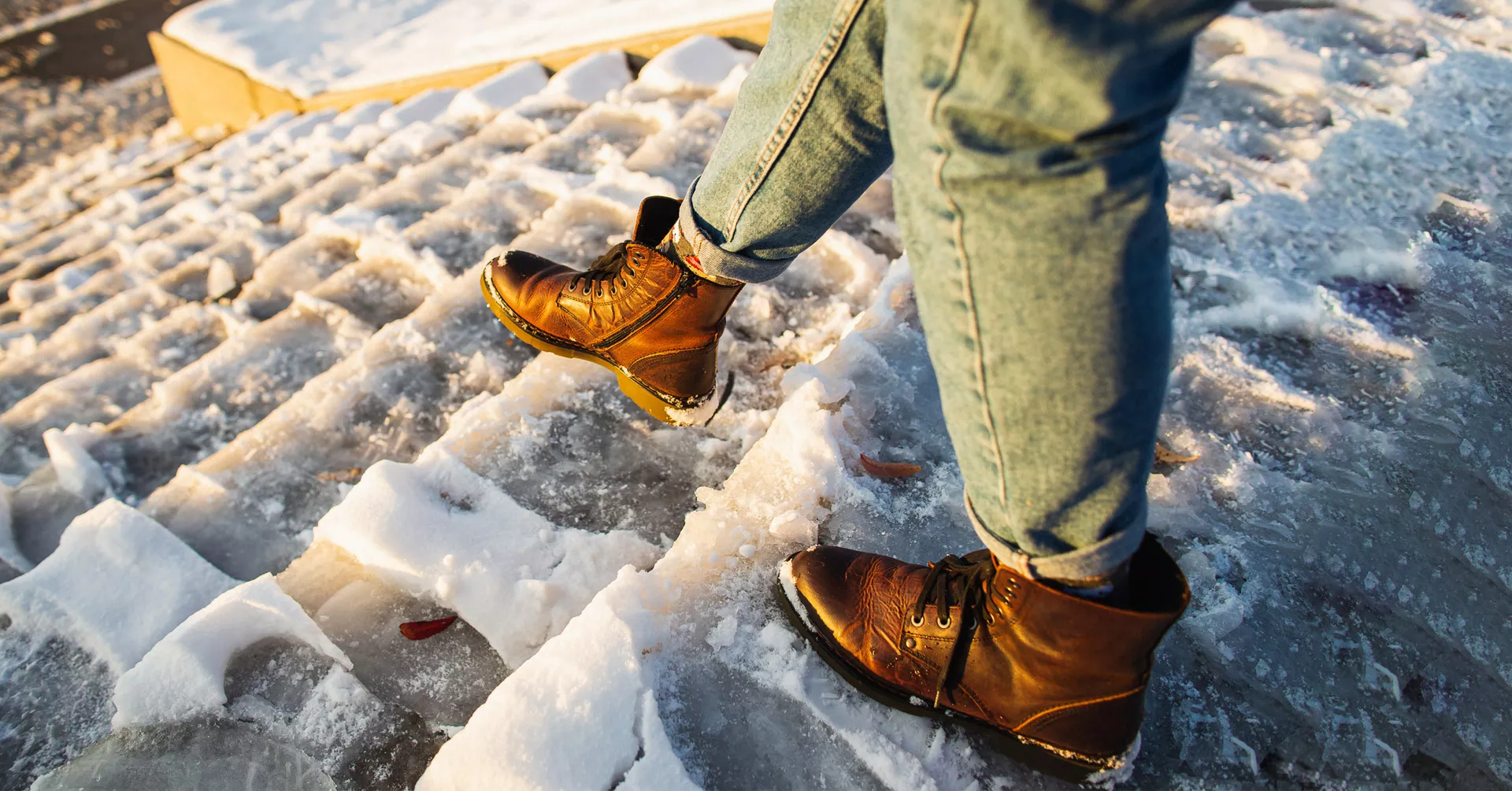
Workplace Safety Checklist
Please complete the form below to receive this resource.
Check Your Inbox!
The document you requested has been sent to your provided email address.
Cookies are required to play this video.
Click the blue shield icon on the bottom left of your screen to edit your cookie preferences.


- Search search
- Slips Trips and Falls
Slips, Trips and Falls
Slips, trips and falls are the most common causes of workplace injuries. Learn about the common hazards and preventive measures to keep the workplace safe.
About Slips, Trips and Falls
Learn the importance of protecting yourself from slips and trips. And find out more about related laws, industry standards and key statistics.
Preventing Slips, Trips and Falls
Learn what you can do to prevent and control slip, trip and fall hazards in the workplace.

17 Jul 2024 Newsletters WSH Insights
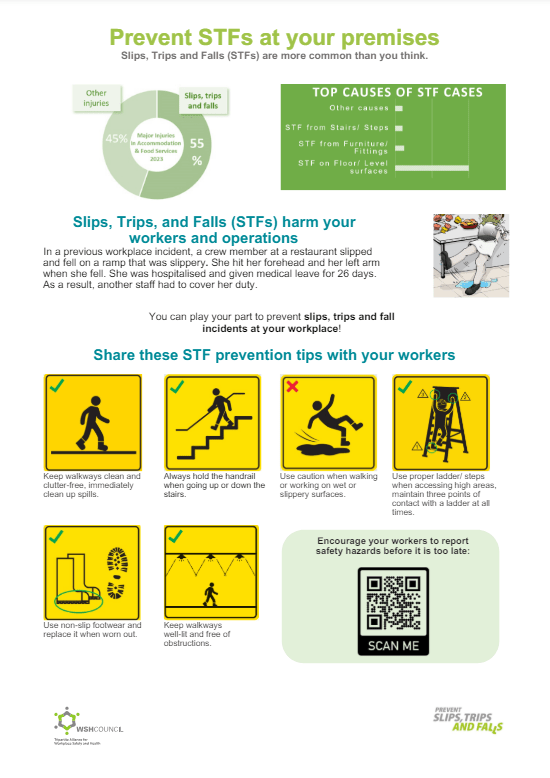
05 Jun 2024 Collaterals Posters

04 Jun 2024 Newsletters WSH Bulletins
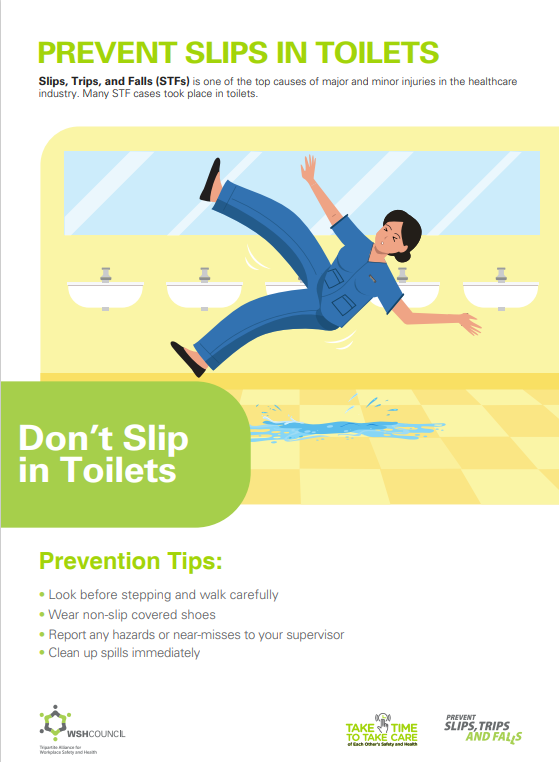
31 May 2024 Collaterals Posters
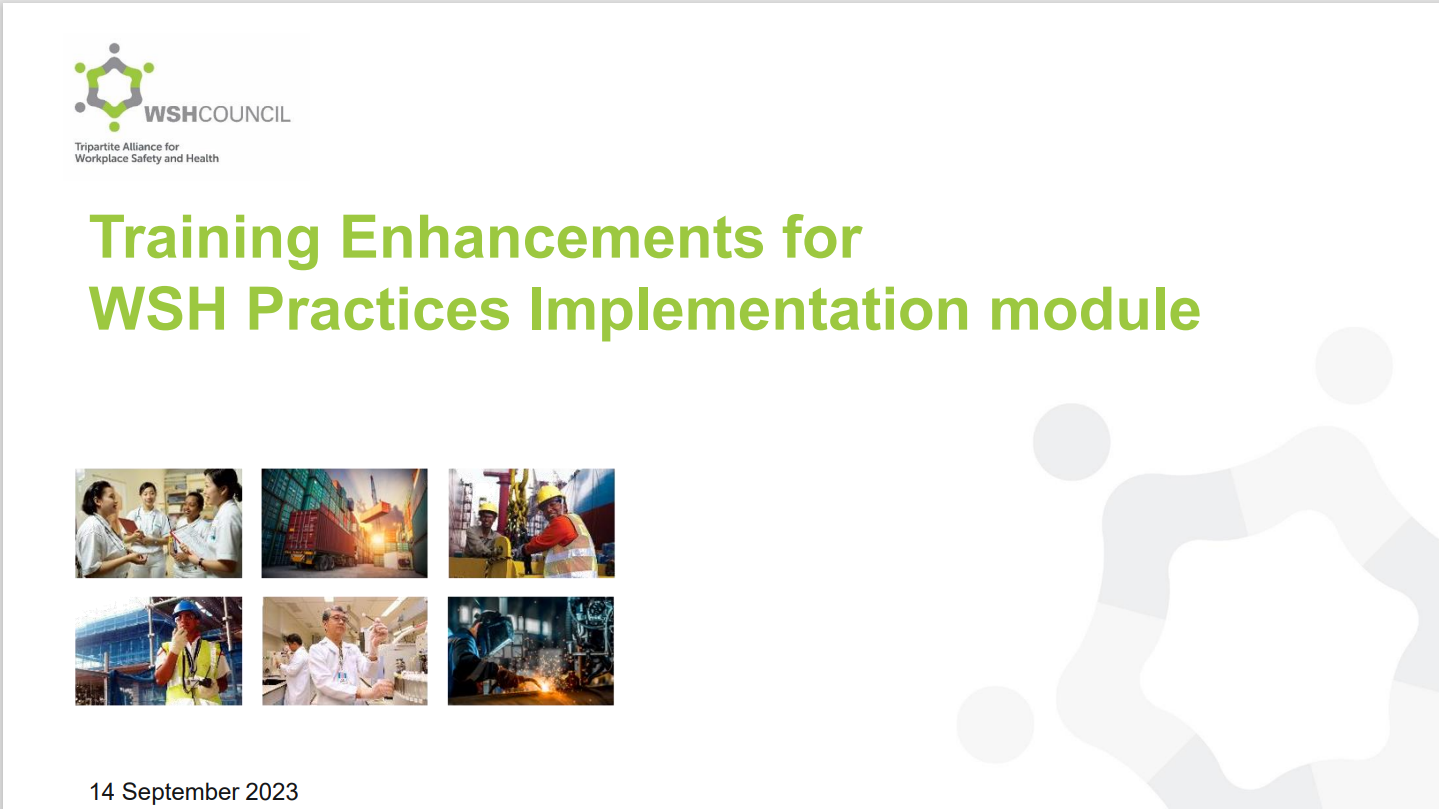
19 Apr 2024 Training Materials Resources for Training Providers
Advisory – Beware of scams and phishing emails
Send us feedback if you receive any suspicious or inappropriate emails asking for your personal information. The email may not have been sent by Workplace Safety and Health Council. Do not click on any link or open any attachments. Your feedback can help us fight against scammers – contact us immediately. We use cookies on wshc.sg to provide a better user experience that's more tailored to you. If you continue, you are giving us your consent to receive cookies only on this site. To decline cookies at any time, simply adjust your browser settings. Read our Privacy Statement.
Slips, Trips, and Falls toolbox talk
A simple, 5 minute outline of what to cover in a toolbox talk on Slips, Trips, and Falls.
Download a Slips, Trips, and Falls toolbox talk pdf
Slips, trips and falls are a common reason for many of the injuries in workplaces. They can cause minor injuries but can also lead to serious, long-term injuries. Many slip, trips and falls are avoidable and there are usually easy solutions a workplace can apply to control the risk, either by eliminating or minimising it. It could be as simple as cleaning up a spillage straight away, or moving a cord off a walkway which can prevent injuries from occurring.
Why run a Slips, Trips, and Falls Toolbox Talk?
- Prevent unnecessary injury from slip, trips and falls by improving awareness and training
- Fewer injuries means higher productivity
- Makes sure workers know what to look for and what to do about it to reduce the risk of an injury occurring
What to watch out for that are common causes of slip, trips and falls?
- Poor housekeeping & messy sites
- Poor lighting
- Uneven walking surfaces
- Clutter on site
- Uncovered cords and cables
- Weather conditions (e.g. rain, ice, dust)
- Obstructed views
- Unsuitable footwear
- Distractions (e.g. cell phone, other workers)
What can you do to help prevent slips, trips and falls occurring?
- Keeping work areas clear & tidy from clutter, obstructions and rubbish
- Any waste placed in designated bins
- Clean up any leaks or spills immediately
- Put tools and equipment away
- Wear suitable footwear (e.g. grippy, anti-slip)
- Ensure work areas are well lit and sufficient light for work
- Keep cords and cables out of walkways, covered or secured
- Be aware of your surroundings and focus on what you are doing
- Work to the weather conditions
What if a slip, trip or fall occurs or nearly occurs?
- Report all slip, trip and fall accidents and near misses, with or without injury, this will help identify the hazards and implement control measures to prevent reoccurrence
Key takeaways
- Simply cleaning up your work area as you go, can help reduce slip, trips and falls
- Make sure you are always aware of your surroundings and look where you are walking
If you see a hazard that has the potential to cause a slip, trip or fall then pick it up or fix it – don’t wait for someone else to do it. Do it yourself!
Sales and Support Inquiries:
- [email protected]
- Help Centre
- Media Enquiries
- Toolbox Talk Topic Tool
- Health & Safety Consultant Directory
- Terms and Conditions
- Privacy Policy
- Account Owner Terms
- Facebook logo to SaferMe FACEBOOK PAGE
- Twitter logo to SaferMe twitter PAGE

IMAGES
VIDEO
COMMENTS
Hazards in the Workplace. In 2022, 865 workers died in falls, and hundreds of thousands were injured badly enough to require days off of work. A worker doesn't have fall from a high level to suffer fatal injuries; 144 workers were killed in falls on the same level in 2022, according to Injury Facts. Construction workers are most at risk for ...
ONTENTSStay Alert—Avoid Slips, Trips, A. FallsOverview momentum to be thrown off balance. Trash, unused materials, ny object left in Slips and falls occur every day. The ex- the aisles or other areas designed for tent of injuries and their. ecurrence can be pedestrian traffic invites falls. Extension minimized through proper safety cords ...
Making sure proper footwear is worn - Non-slip shoes with good traction protect workers from static electricity, falling objects, explosions, exposure to hazardous substances, and other risks. Maintaining and improving floor quality - Modifying the floor space can go a long way to ensure safety from slips, trips, and falls.
Slips, trips, and falls cause nearly 700 fatalities per year and many more injurious accident in the workplace according to the Bureau of Labor Statistics. There are three physical factors involved in slips, trips, and falls: friction, momentum, and gravity. Each one plays a role. Friction is the resistance between objects, momentum is affected ...
Slips, trips, and falls are preventable accidents that carry substantial personal, economic, and societal costs. By comprehending the causes, consequences, and prevention strategies, we can significantly reduce the incidence of STFs and mitigate their impact. Whether at home, at work, or in public spaces, prioritizing safety and fostering awareness about STFs is crucial for the well-being of ...
National Safety Month Week 3. Slips, trips and falls are no laughing matter. In fact, they can be deadly: According to the 2017 edition of "Injury Facts," an NSC chartbook, 660 workers died in 2014 after a fall from height, and 138 workers died from a fall on the same level.
Dec 17, 2020. Slips, trips and falls accounted for in 2019. These types of hazards exist in many work environments, but organizations can take simple steps to mitigate or eliminate them. This week's Safety News You Need features tips and tools you can use to help workers keep their footing while on the job. Slips, trips and falls can occur ...
Slips, Trips, and Falls Prevention. Some slip, trip, and fall prevention measures are permanent, including: Adequate lighting. Handrails. Slip-resistant surfaces in high-risk areas. Effective drainage, ventilation, and other methods to keep surfaces dry. Marking the edges of steps or elevation changes.
Fall hazards remain a common problem across multiple industries and workplaces. In 2019, worker deaths stemming from slips, trips and falls climbed 11.3% from the previous year, according to Bureau of Labor Statistics data. Meanwhile, OSHA's standard on fall protection - general requirements (1926.501) has topped the agency's Top 10 list ...
Data. Falls to a Lower Level. Falls on the Same Level. Top Work-related Injuries. Resources and data on slips, trips and falls curated by NSC experts. Here you'll find training, articles on fall hazards, technology resources for working safely at heights and much more.
February 25, 2015. Slips, trips and falls are a problem in workplaces in almost every industry. A recent survey of safety professionals revealed the biggest three causes of slips trips and falls—and the results should make safety folks sit up and take notice. It turns out that the majority of slips, trips and falls involve human factors.
A water spill or debris on floors resulting from poor housekeeping can often increase the potential for a slip event. Finally, make sure the appropriate staff are made aware so as to ensure the situation is addressed as soon as possible. Trips—. Trips are another claim area we can work together with our colleagues to address by being vigilant ...
Slips, trips, and falls on the same level have consistently appeared among the top causes of workplace injuries in the U.S. 1,2 In 2021, there were nearly 139,000 nonfatal, same-level falls that resulted in days away from work. 3 That means an average of nearly 560 same-level falls each day, based on about 250 workdays (without weekends and holidays). A troubling rate of same-level falls ...
revent slips, trips and fall. ean up spills immediately. Install warning signs for wet floor areas (in. uding freshly mopped floors).Wear shoes with good support and slip-resistant sole. appropriate for the job task.Remove tripping hazards in. walkways, doorways and stairs. Keep drawers and cabin.
Items marked "Add to cart" are available in print. You can request up to 5 copies each or 5 different publications through this webpage. when requesting more than 5 copies each or 5 different publications. Your search for slips, trips and falls has returned the following results. Disaster Response: Protecting Workers from Slips, Trips and Falls ...
Here are eight workplace safety tips to prevent falls, trips, and slips. 1. Teach situational awareness. Since many causes of slips, trips, and falls are foreseeable, situational awareness in the workplace is one of the best preventative measures. Encourage your employees to pay attention to their surroundings and the risks they present:
Slip, Trip and Fall Hazards. Slips, trips and falls can happen in any workplace, and should not be overlooked. They can cause: Minor injuries such as sprains and strains. Broken bones due to the impact when trying to break the fall. Back injuries due to the impact from the fall. Cuts if the incident occurs near sharp objects.
Risk factors include physical hazards in the environment, age-related issues and health conditions. Reduce your risk and find fall hazards in your workplace and home to prevent injuries and keep others safe round the clock. This webpage has resources on preventing slips, trips, and falls, including posters, quizzes, and fact sheets.
Slips, Trips and Falls. Every year, we look forward to working with NSC to amplify our safety messaging during National Safety Month. Our goal is to create healthier, safer environments where CDC staff can work optimally from anywhere. As a public health agency, we talk about our commitment to saving lives and protecting people 24/7 to the ...
About Slips, Trips and Falls Learn the importance of protecting yourself from slips and trips. And find out more about related laws, industry standards and key statistics. ... 17 Jul 2024 Newsletters WSH Insights. WSH Insights 17 July 2024 Preventing Slips, Trips and Falls. 05 Jun 2024 Collaterals Posters. Prevent Slips, Trips and Falls at your ...
Download a Slips, Trips, and Falls toolbox talk pdf. Slips, trips and falls are a common reason for many of the injuries in workplaces. They can cause minor injuries but can also lead to serious, long-term injuries. Many slip, trips and falls are avoidable and there are usually easy solutions a workplace can apply to control the risk, either by ...
organizing your home to avoid climbing, stretching, or bending for things. checking any pets are out of your way before walking. avoiding standing or climbing on something to reach an item that is high up. avoiding walking on slippery or recently wet floors, and cleaning up spills immediately.
The National Safety Council is the leading nonprofit safety advocate. We focus on eliminating the leading causes of preventable injuries and deaths.